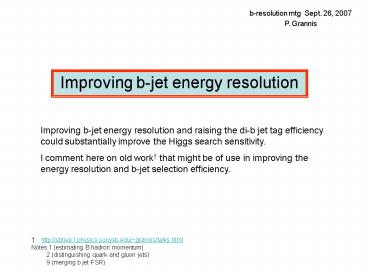Improving bjet energy resolution - PowerPoint PPT Presentation
1 / 5
Title:
Improving bjet energy resolution
Description:
I comment here on old work that might be of use in improving the energy ... Comment on b-jet tagging. Any gain in b-tag efficiency is worth having. ... – PowerPoint PPT presentation
Number of Views:35
Avg rating:3.0/5.0
Title: Improving bjet energy resolution
1
b-resolution mtg Sept. 26, 2007 P. Grannis
Improving b-jet energy resolution
Improving b-jet energy resolution and raising the
di-b jet tag efficiency could substantially
improve the Higgs search sensitivity. I comment
here on old work that might be of use in
improving the energy resolution and b-jet
selection efficiency.
http//sbhep1.physics.sunysb.edu/grannis/tal
ks.html Notes 1 (estimating B hadron momentum)
2 (distinguishing quark and gluon jets)
9 (merging b jet FSR)
2
Estimating unknown kinematic quantities (e.g.
b-jet energy)
1994 OPAL study how to make the best estimate
of momentum of a semileptonic B meson for
oscillation measurements? OPAL had a
complicated lookup function based on several
kinematic quantities. My method used a property
of the H matrix that allows an unmeasured
quantity xN (in OPAL, case B momentum) to be
predicted from a set of observed quantitites
xi, i 1 N-1. Let mi be the mean value of
the xi over a training sample.
From MC training sample (or special data)
generate Mij (1/Nevt) ?evts(xi-mi)(xj-mj). Form
H M-1 For each event in real sample, z ?ij
(Dxi Hij Dxj) (Dxj xj-mj ) (With no
unknown variable xN, z would be the H matrix c2
as used for e-ID) Can decompose z z1 z2 ,
with z1 ?Dxi Hij Dxj (i,j summed from 1 to
N-1)
and z2 2DxNHiNDxi DxNHNNDxN (sum on
i) Then minimizing z with respect to xN yields
best shift from mN to true xN for this event
xN mN (? HiN Dxi )/HNN
3
For OPAL study (paper 1 above), took observed
variables (Evis, Efrag, lepton momentum, decay
length, DL error, jet mass, multiplicity, etc) to
predict the B hadron momentum.
Estimated momentum for MC Bs improved older
method by 6. Non-gaussian tail was also
present in the older method, but could be reduced
by breaking the sample into different decay
length bands.
Requiring DL gt 2mm reduced spread by another 10.
Can this method be used to estimate the b-parton
energies for each jet in DØ Higgs studies? (Is
there a corresponding method for predicting the
unmeasured using NNs?)
4
What variables might be used to predict Eb? A
separate OPAL study (paper 2 above) sought to
distinguish quark and gluon jets using energy
(and multiplicity) in a set of 10 annular cones
around the jet axis. The H matrix chisquares, zg
and zq, for conforming to gluon or quark
hypotheses were formed and the difference, Dz
(Fisher discriminant), obtained.
Keeping only subsample of events to left of red
line or right of blue line could give 65
quark/gluon purity with 60 efficiency. Not
great, but enhanced samples.
quark like
gluon like
quarks
But the variables used do seem to have some
discrimination power. b-jets are perhaps more
different from light quarks than gluons!
gluons
Dz
- A potential set of variables for b-jet energy
estimate might be - Visible jet energy
- Energy profile (energy into annular subcones)
- Jet mass
- Nearby lepton energy, pTrel
- Info on nearest jet DR and Ejet (to account for
FSR gluon radiation) (I tried once to improve
Higgs di-b resolution by merging jets near a
b-jet if low invariant mass no success!) (paper
9 above) - Ideas, study and optimization clearly needed.
5
Comment on b-jet tagging
Any gain in b-tag efficiency is worth having.
Current analyses (e.g. Z(ll)H use fixed cuts on
NN probability for both b-jets. Doing
2-dimensional cuts on b-ID may offer significant
efficiency improvement for fixed background.
Study in Y. Mutaf thesis (Zb cross section) a)
Selecting di-lepton with cut on product of
isolation probabilities raises efficiency for
fixed background significantly. This method is
now incorporated in the p17 analyses.
independent cuts
product cut
?
b) The same technique can be used in selecting
the di-b jets (currently not used for the double
tag p17 analyses). The optimization of a 2-d cut
depends on the channel and background/signal
ratios. For the p14 analysis, Mutaf found that a
single jet fake rate of 3.6 optimized S/v(SB),
higher than that used then. p17 analysis now
uses 6 fake rate for DT NN analysis.
?
product cut
Further, he found that using a cut on the product
P1P2 (Pi prob. jet i is light quark) gave 50
improvement in signal efficiency for the optimum
fake background. This is not being done in the
current p17 analyses, and should be pursued.
independent cuts
!
optimum mistag rate































